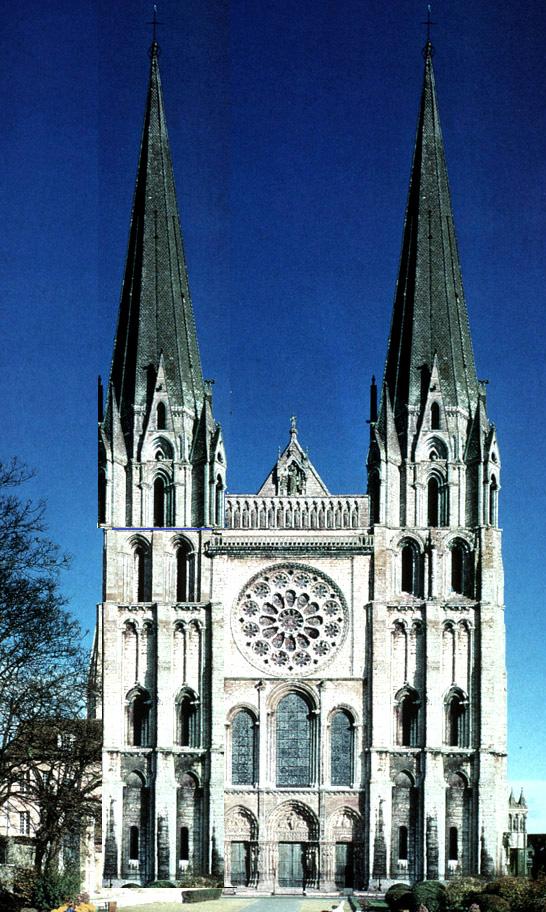
Few of the historic monuments of France inspire as much admiration and awe as the Gothic cathedrals of the Île-de-France and surrounding areas. Many people are familiar with the Notre-Dames of Paris and Chartres, but there are abundant other examples in northern France, in Caen, Laon, Reims, Amiens, Bourges, Beauvais, and elsewhere. Our November 16 Pause-Déjeuner focused on the origins, structures, and diversity of these ecclesiastical and architectural achievements of the High Middle Ages. Robert Hajdu, a medieval historian, retired lawyer, and grand amateur of Gothic cathedrals, provided an informative and wonderfully illustrated presentation.
Few who stand in front of Notre-Dame de Paris think of its architectural origins, but it is the culmination of a trajectory in major church building, edifices for bishops and especially archbishops (as Hajdu pointed out, the term cathedral comes from the Latin cathedra or “seat” for the presiding cleric). The earliest cathedrals are the late Roman basilicas, such as the magnificent Basilica di San Vitale in Ravenna, Italy. They were followed, in the tenth and eleventh centuries, by the Romanesque churches, from small village churches to large urban cathedrals, that today are scattered across all of France but mostly south of the Loire. Among them, as Hajdu explained, there are spectacular Romanesque cathedrals ranging from Toulouse (Saint-Sernin) in Languedoc to Caen (Saint-Étienne) in Normandy, including Notre Dame-la-Grande in Poitiers and the abbatial church at Saint–Savin, both in Poitou. Even though these Romanesque churches relied on the heavier architecture of rounded arches and barrel vaults, the larger ones nonetheless achieved substantial heights (literally and figuratively). This section of the presentation was intended as a background to the Gothic cathedrals, yet it left me wanting to visit or revisit some of these majestic Romanesque edifices.
Hajdu spent some time on Notre-Dame de Chartres, built around 1200 C.E. With its symmetrical floor plan, tripartite elevation, greatly expanded clerestory, pristine stained-glass windows, and large rose windows, Chartres represents the ultimate accomplishment of Gothic architecture. Most notably, as Hajdu emphasized, the long nave, the high vault, the abundance of windows, and the double-aisled apse provide an interior sense of space, symmetry, and illumination, a grandeur that would have been difficult to acquire with heavier Romanesque architecture. If the interior walls were unpainted, a debated question, there would have been a wonderful play of light throughout the cathedral.
Hajdu brought this sense of grandeur home with a photograph of Notre-Dame de Chartres seen from across the rolling wheatfields of the Beauce (the breadbasket of France since the Middle Ages). The cathedral appears to rise out of the landscape, and it certainly towers over the surrounding town of Chartres. One can only wonder whether the Gothic cathedrals, currently in the middle of the modern cities of Paris, Bourges, Amiens and Reims, would have towered similarly over the twelfth- and thirteenth-century cities in which they were built. Notre-Dame de Chartres, and as well as Saint-Pierre de Beauvais in Picardy, bring home the degree to which these cathedrals were reaching to the heavens when they were built.
At a more technical level, Hajdu explained how late medieval architects and stonemasons, largely through trial and error, achieved the heights and lights of these churches. By combining pointed arches (to direct weight down rather than out), abundant windows (both to lighten the walls and to light the interiors), ribbed vaults (to lessen the roof weight on the walls), and flying buttresses (to keep the walls from being pushed out), they were able to raise the naves, transepts, and apses and enlarge the clerestories to produce their effects. The ultimate example is the partial cathedral at Beauvais, which consists of only the thirteenth-century choir and apse and a sixteenth-century transept. It was the tallest building attempted at the time, but the nave was never built—the choir partially collapsed, and the workmen refused to continue. It represents the pinnacle of Gothic architectural hubris; its creators had reached the limits of what they could build with their knowledge, skill, and materials.
Gothic cathedrals, which emerged in northern France and spread into neighboring countries and across the channel to Britain, have become symbolic of the High Middle Ages. Centrally located ones, such as Notre-Dame de Paris, have been inundated by tourists (at least before the roof burned in 2019), and Notre-Dame de Chartres is on the route of every tour bus. They are justifiably revered for their elegance, symmetry, and artistic decoration. At the same time, they are admirable as architectural achievements in societies that lacked the engineering knowledge that we take for granted. And they reflect societies, with levels of both poverty and excess, that we would find inconceivable yet all too familiar.
—Erik Trinkaus
TIle photo courtesy Unsplash. This post was updated on November 20.
